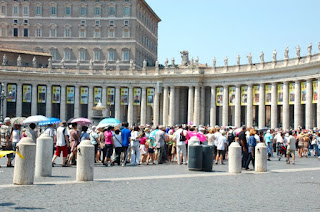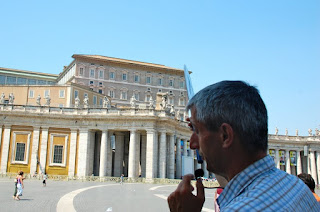The Moment I'd been waiting for all week...
*VATICAN CITY*
The most amazing fact about Vatican City is that it is the smallest sovereign state in the world. Vatican City in spite of being a part of Italy strangely stands out as an independent state. It was not this way always; the Lateran Treaty established the state after a long series of disputes with the Italian government and gradually the king was taking over the authority but then the Lateran Treaty made Vatican City independent in 1929 and with that Roman Catholicism earned a special place for it in Italy.
Vatican City, the place where the sun rises and sets past the dome of St. Peter’s Basilica designed by the legend himself, the great Michelangelo.
The Vatican City is the smallest country in the world with the smallest population. It measures 44 hectares ( 110 acres) and has a population of about 1000 people.
- There is still monarchy in Vatican City though it is not hereditary and is ruled by whoever becomes the Bishop of Rome, that is the Pope who is elected.
The Vatican has its own Post office and issues its own stamps. The Vatican mail system is widely used by Romans as in most cases is a lot quicker than Italian mail.
Piazza di San Pietro (St Peter's Square) and the colonnade were designed and built by Bernini (completed in 1667). At 314 meters long and 240 meters wide it is the largest square in Rome. Bernini (with the help of his pupils) designed the 140 statues of saints which decorate the colonnade.
The Vatican's radio station is located in a tower inside the Vatican Gardens and broadcasts in 20 languages throughout the world.
The Papal Basilica of Saint Peter, officially known in Italian as Basilica Papale di San Pietro in Vaticano and commonly known as St. Peter's Basilica, is a Late Renaissancechurch located within the Vatican City. St. Peter's Basilica has the largest interior of any Christian church in the world. It is regarded as one of the holiest Catholic sites. It has been described as "holding a unique position in the Christian world" and as "the greatest of all churches of Christendom".
The line within the walls of Vatican City was enormous! The wait to get into the Basilica was over 2 hours!
(Thank goodness for our tour tickets - we were able to scoot to the front of the line!!)
There are no words to describe the MAJESTIC BEAUTY that this Basilica is...so, I'll let the pictures do the work. And, keep in mind - these pictures do NOT do it justice!!
In Catholic tradition, the basilica is the burial site of its namesake Saint Peter, who was one of the twelve apostles of Jesus and, according to tradition, first Bishop of Rome and therefore first in the line of the papal succession. Tradition and some historical evidence hold that Saint Peter's tomb is directly below the altar of the basilica. For this reason, many Popes have been interred at St. Peter's since the Early Christian period. There has been a church on this site since the 4th century. Construction of the present basilica, over the old Constantinian basilica, began on 18 April 1506 and was completed on 18 November 1626.
Many guests of the Basilica stood in a long line in order to get a moment with the cross - they would touch the cross and say a prayer
This is probably the world's most famous sculpture of a religious subject. Michelangelo carved it when he was 24 years old, and it is the only one he ever signed. The beauty of its lines and expression leaves a lasting impression on everyone.
With this magnificent statue Michelangelo has given us a highly spiritual and Christian view of human suffering. Artists before and after Michelangelo always depicted the Virgin with the dead Christ in her arms as grief stricken, almost on the verge of desperation. Michelangelo, on the other hand, created a highly supernatural feeling.
As she holds Jesus' lifeless body on her lap, the Virgin's face emanates sweetness, serenity and a majestic acceptance of this immense sorrow, combined with her faith in the Redeemer. It seems almost as if Jesus is about to reawaken from a tranquil sleep and that after so much suffering and thorns, the rose of resurrection is about to bloom. As we contemplate the Pieta which conveys peace and tranquility, we can feel that the great sufferings of life and its pain can be mitigated.
The gold banner with the letters at top measures 10 feet tall!
It was St. Peter's Day - he gets his royal garb put on by the pope - we missed seeing this by an hour!!
yes - that is an actual pope!
Though, like various European powers, earlier Popes recruited Swiss mercenaries as part of an army, the Pontifical Swiss Guard was founded by Pope Julius II on 22 January 1506 as the personal bodyguard of the Pope and continues to fulfil that function. It is listed in the Annuario Pontificio under "Holy See", not under "State of Vatican City". At the end of 2005, the Guard had 134 members. Recruitment is arranged by a special agreement between the Holy See and Switzerland. All recruits must be Catholic, unmarried males with Swiss citizenship who have completed their basic training with the Swiss Army with certificates of good conduct, be between the ages of 19 and 30, and be at least 175 cm (68.90 in) in height. Members are armed with small arms and the traditional halberd (also called the Swiss voulge), and trained in bodyguarding tactics.
The Vatican museums are over 9 miles (14,5 kilometers) long, and it is said that if you spent only 1 minute admiring each painting it would take you 4 years to complete the circuit!
In the eastern wing (facing towards Rome) of the residential section the pope occupies two floors. On the upper floor (the third) he resides with his two private secretaries and some servants; on the second floor he works and receives visitors. One suite of rooms receives the morning, and the other the midday and afternoon sun. The second floor includes the reception rooms, which the visitor enters through the wonderful Sala Clementina, where a division of the Swiss Guards keep watch at the entrance to the papal apartments.
Vatican City Shopping
The City of Rome
Pizza!
The Fontana di Trevi or Trevi Fountain
is the most famous and arguably the most beautiful fountain in all of Rome.
The Trevi Fountain as we know it today, was designed by Nicola Salvi in 1732 and competed in 1762.
 The central figures of the fountain are Neptun (God of the sea), flanked by two Tritons. One struggles to master a veru unruly "sea horse", the other lead a far more docile animal. These symbolize the two contrasting moods of the sea.
The central figures of the fountain are Neptun (God of the sea), flanked by two Tritons. One struggles to master a veru unruly "sea horse", the other lead a far more docile animal. These symbolize the two contrasting moods of the sea.As the original legend goes, if you stand with your back to the Trevi Fountain and throw a coin into the fountain (with your right hand throwing the coin over your left shoulder), you will be sure to return to Rome. Since time immemorial, visitors to Rome have been coming to the Trevito throw their coin, each one wanting to ensure a return to the External City.
Movies like “Roman Holiday”, “La Dolce Vita” and “Three Coins in the Fountain” have helped to make Trevi Fountain famous around the world. The 1954 romantic comedy “Three Coins in the Fountain” added a different perspective to coin throwing. The three American girls working at the American Embassy dream of finding romance in Rome and come to the Fountain to make their wish and as the lyrics go:
Three Coins in the Fountain
Each one seeking happiness
Thrown by three hopeful lovers
Which one will the fountain bless?
Just one wish will be granted. Make it mine, make it mine, make it mine!
Authentic Italian Gelato - YUMMO!
Marco commissions #17 tourists to convene for departure
Time to say goodbye to the AMAZINGLY ASTONISHING city of ROME!!!!
After 12 hours of the most incredible sight seeing I've ever had in my life...it is time to put on my heels for the 5th night in a row! Tonight - meeting our amigo's Vaughn & Florence for some....
BEATLE MANIA!
A fabulous way to end a fantabulous day!!


























































































































No comments:
Post a Comment